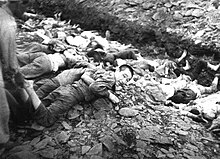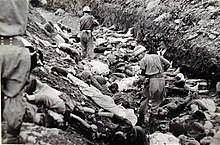Bodo League massacre
| Bodo League massacre | |
|---|---|
 Summary execution of South Korean political prisoners by the South Korean military and police at Daejeon, South Korea | |
| Location | South Korea |
| Date | Summer of 1950 |
| Target | Communists and alleged communist sympathizers[1] |
Attack type | Massacre |
| Deaths | 60,000[2] to 200,000[3] |
| Perpetrators | South Korean police, military, and anti-communists on direct orders from President Syngman Rhee |
| Motive | Anti-communism; fear of North Korean fifth column |
The Bodo League massacre (Korean: 보도연맹 학살; Hanja: 保導聯盟虐殺) was a massacre and a war crime against communists and alleged communist-sympathizers (many of whom were civilians who had no connection to communism or communists) that occurred in the summer of 1950 during the Korean War. Estimates of the death toll vary. Historians and experts on the Korean War estimate that between 60,000[2] and 200,000 people were killed.[3]
The massacre was committed by the government forces of president Syngman Rhee and falsely blamed on the communists led by North Korean leader Kim Il Sung.[4] The South Korean government made efforts to conceal the massacre for four decades. Survivors were forbidden by the government from revealing it, under threat of being treated as communist sympathizers; public revelation carried with it the threat of torture and death. During the 1990s and onwards, several corpses were excavated from mass graves, resulting in public awareness of the massacre.[5][6] Half a century after the massacre, the Truth and Reconciliation Commission investigated this among other incidents that were largely kept hidden from history, unlike the well-publicized North Korean executions of South Korean right-wingers.[7]
Bodo League

South Korean President Syngman Rhee had[year needed] about 300,000 suspected communist sympathizers or his political opponents enrolled in an official "re-education" movement known as the National Bodo League[8] (or National Rehabilitation and Guidance League, National Guard Alliance,[9] National Guidance Alliance,[10] Gukmin Bodo Yeonmaeng,[9] 국민보도연맹; 國民保導聯盟) on the pretext of protecting them from execution.[4][9][11] The Bodo League was created by Korean jurists who had collaborated with the Japanese colonial government.[12] Non-communist sympathizers and others were also forced into the Bodo League to fill enlistment quotas.[8][11]
In June 1949, the South Korean government accused independence activists of being members of the Bodo League.[9] In 1950, just before the outbreak of the Korean War, the first president of South Korea, Syngman Rhee, had about 20,000 alleged communists imprisoned.[13]
Executions


Under the leadership of
United States official documents show that American officers witnessed and photographed the massacre.
There were also British and Australian witnesses.
Daejeon
| Daejeon Massacre | |
|---|---|
| Date | 28 June 1950 – 16 July 1950 |
| Target | Communists and suspected communist sympathizers |
Attack type | Massacre |
| Deaths | 4000–7000[26] |
| Perpetrator | South Korean anti-communists |
| Daejeon Massacre | |
| Hangul | 대전형무소 학살 사건 |
|---|---|
| Revised Romanization | Daejeonhyeongmosu Haksal Sageon |
| McCune–Reischauer | Taejonhyungmosu Haksal Sagon |
As the North Korean army was nearing Daejeon, the South Korean paramilitary forces executed around 7,000 political prisoners, men, women, and children in mass graves as American officers took photographs which were kept classified until they were released in 1999. This was merely one of many such mass killings conducted by South Korean forces against political prisoners in the first months of the war. Many, including the Daejon Massacre, were propagandistically blamed on the North Koreans.[27][7][28]
Aftermath
After the UN offensive in which South Korea recovered its occupied territories, the police and militia groups executed suspected North Korean sympathizers. In October 1950, the Goyang Geumjeong Cave massacre occurred. In December, British troops saved civilians lined up to be shot by South Korean officers and seized one execution site outside Seoul to prevent further massacres.[10][25] On 4 January 1951, the Ganghwa massacre was committed by South Korean police, who killed 139 civilians in an effort to prevent their collaboration with the North Koreans. According to a South Korean report, South Korea and the U.S. "aided right-wing civil organizations, such as the Ganghwa Self-defense Forces, by providing combat equipment and supplies."[29]
Truth and Reconciliation Commission
In 2008, trenches containing bodies were discovered in Daejeon, South Korea, and other sites.[22][30][3] South Korea's Truth and Reconciliation Commission documented testimonies of those still alive and who took part in the executions, including former Daejeon prison guard Lee Joon-young.
Besides photographs of the execution trench sites, the National Archives in Washington D.C. released declassified photographs of U.S. soldiers at execution sites including Daejeon, confirming American military knowledge.[10]
See also
- List of massacres in South Korea
- Jeju Uprising
- Gyeongsan Cobalt Mine massacre
- Anti-communist mass killings
References
- ^ Kim 2004, p. 533.
- ^ a b "Summer of Terror: At least 100,000 said executed by Korean ally of US in 1950 [with interactive video]".
- ^ a b c d e Charles J. Hanley & Hyung-Jin Kim (10 July 2010). "Korea bloodbath probe ends; US escapes much blame". San Diego Union Tribune. Associated Press. Archived from the original on 19 October 2012. Retrieved 23 May 2011.
- ^ a b c d e f "South Korea owns up to brutal past". The Sydney Morning Herald. 2007. Retrieved 15 December 2008.
- ^ "진실화해위 "보도연맹원 4천934명 희생 확인"".
- ^ "공감언론 뉴시스통신사". Newsis (in Korean). Retrieved 15 February 2017.
- ^ a b "AP: U.S. Allowed Korean Massacre In 1950". www.cbsnews.com. 5 July 2008.
- ^ Hankyoreh. 25 June 2007. Retrieved 22 July 2010.
- ^ Hankyoreh. 23 January 2010. Retrieved 22 July 2010.
- ^ a b c d e f Writers Charles J. Hanley and Jae-Soon Chang (11 February 2009). "U.S. Allowed Korean Massacre In 1950". CBS. Associated Press. Archived from the original on 24 April 2013. Retrieved 20 April 2012.
- ^ Korea Times. Retrieved 18 July 2011.
- ^ ISBN 9780199831494.
- ^ Kim 2004, p. 526.
- ISBN 0-688-09513-5.
- Hankyoreh(in Korean). 25 June 2010. Retrieved 14 July 2010.
- ^ Ohmynews (in Korean). 4 July 2007. Archived from the originalon 3 May 2011. Retrieved 14 July 2010.
- ^ 헌병대의 보도연맹원 '대량학살' 최초 구체증언 확보 6.25 당시 헌병대 과장 김만식 씨 증언 토대, 전국 조직적 학살 자행. CBS (in Korean). 4 July 2007. Retrieved 14 July 2010.
- ^ Kim Young Sik (17 November 2003). "The left-right confrontation in Korea – Its origin". asianresearch.org. Archived from the original on 29 March 2008. Retrieved 15 December 2008.
- ^ a b c d e "New evidence of Korean war killings". BBC. 21 April 2000. Retrieved 23 July 2010.
- ^ Kim 2004, p. 534.
- ^ a b "AP: U.S. Allowed Korean Massacre In 1950". www.cbsnews.com. 5 July 2008. Retrieved 30 October 2021.
- ^ Fox News. Associated Press. Retrieved 28 June 2013.
- ISBN 9780810874619.
- Hankyoreh. 3 March 2009. Retrieved 13 July 2010.
- ^ a b "Unearthing proof of Korea killings". BBC. 18 August 2008. Retrieved 23 July 2010.
- ^ "The South Korean Massacre at Taejon: New Evidence on US Responsibility and Coverup".
- ^ McDonald, Hamish (15 November 2008). "South Korea owns up to brutal past". The Sydney Morning Herald.
- ^ Sang-Hun, Choe (26 November 2009). "South Korean Commission Details Wartime Massacres". The New York Times.
- ^ "Truth and Reconciliation: Activities of the Past Three Years" (PDF). Truth and Reconciliation Commission, Republic of Korea. pp. 74–75. Archived from the original (PDF) on 3 March 2016. Retrieved 30 January 2016.
- ^ JUNG, Yoon Duk (9 February 2023). "대전 골령골서 민간인 학살 희생자 유해 모두 1천441구 발굴" [Excavation of 1,441 remains of civilian massacre victims in Golyeonggol, Daejeon]. YTN NEWS (in Korean). Retrieved 24 March 2023.
Works cited
- Kim, Dong-Choon (December 2004). "Forgotten war, forgotten massacres – the Korean War (1950–1953) as licensed mass killings". Journal of Genocide Research. 6 (4): 523–544. S2CID 74141018.
External links
- Mass Killings in Korea – Commission Probes Hidden History of 1950, Associated Press (Video and Documents)
- Unearthing War's Horrors Years Later in South Korea, The New York Times, 3 December 2007.
- TRCK confirms hundreds of villagers were massacred during onset of Korean War The commission advises an official state apology and will continue investigations of the National Guard Alliance through the end of the year, Hankyoreh, 17 November 2009.
- Truth commission confirms Korean War killings by soldiers and police 3,400 civilians and inmates were shot dead or drowned out of concerns they might cooperate with the People's Army, Hankyoreh, 3 March 2009.
- A/V Geeks (22 June 2014). "Crime of Korea, The (1950)" – via YouTube.
